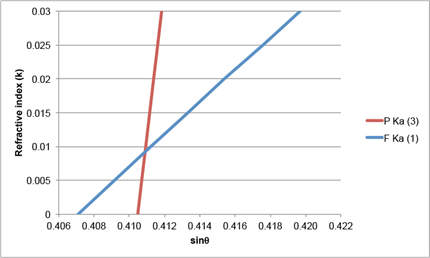BRAGG'S LAW
In 1913, the father-son team of William H + William L Bragg built an X-ray spectrometer, using NaCl to resolve Pt X-rays. For this they received the Nobel Prize in 1915.

where
:
 is the order of the x-ray (1st, 2nd, etc.)
is the order of the x-ray (1st, 2nd, etc.)
 is the wavelength in angstroms
is the wavelength in angstroms
 is the
analyzing crystal 2d spacing in angstroms
is the
analyzing crystal 2d spacing in angstroms
 is the angle of diffraction
is the angle of diffraction
There is a more precise form of Bragg's Law that allows for refraction of x-rays by the crystal or diffractor; this can be shown as a modification of the 2d such that d' = d[1-(k/n2)] where n is the order of reflection and k is a constant for each crystal.

Plot from Julien Allaz
These constants range from 6x10-5 for LiF to 2.2x10-3 for TAP (Reed, 1993). They can cause higher order lines to "cross over" and appear on the opposite side of a peak, such as the 3rd order P Ka upon the F Ka for LDEs. Probe for EPMA automatically uses this precise calculation.